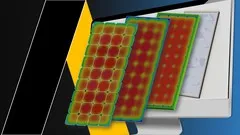
Creo Ansys Simulation 
This course will teach students how to use Creo 7.0.2.2 and Ansys to create simulation driven designs. Students will learn how to use Creo 8.0 and Ansys to create accurate simulations and how to use Creosystem.com to access the latest tools and resources. The course will also cover the fundamentals of simulation driven design and how to use it to create better products. ▼
ADVERTISEMENT
Course Feature
![]() Cost:
Cost:
Free
![]() Provider:
Provider:
Youtube
![]() Certificate:
Certificate:
Paid Certification
![]() Language:
Language:
English
![]() Start Date:
Start Date:
On-Demand
Course Overview
❗The content presented here is sourced directly from Youtube platform. For comprehensive course details, including enrollment information, simply click on the 'Go to class' link on our website.
Updated in [May 25th, 2023]
This course provides an overview of Creo Ansys Simulation, a powerful simulation-driven design tool. Participants will learn how to use Creo 7.0.2.2 and Creo 8.0 to create accurate simulations of their designs. The course will cover the basics of Ansys and PTC, as well as the Creosystem.com platform. Participants will gain an understanding of how to use Ansys and PTC to create simulations that are accurate and reliable. They will also learn how to use Creosystem.com to access and manage their simulations. At the end of the course, participants will have a better understanding of how to use Creo Ansys Simulation to create accurate simulations of their designs.
[Applications]
The application of this course can be seen in the use of Creo 7.0.2.2 and Creo 8.0 for simulation driven design. With the help of Ansys and PTC, users can create accurate simulations of their designs and use the results to make informed decisions. Additionally, Creosystem.com provides a platform for users to access Ansys, PTC, and Creo resources. This course can also be used to gain a better understanding of the fundamentals of simulation driven design and how to apply them in a practical setting.
[Career Paths]
1. Simulation Engineer: Simulation Engineers are responsible for developing and maintaining simulation models and tools to analyze and optimize product designs. They use a variety of software tools such as Ansys, PTC, and Creo to create and analyze simulations. As the demand for more efficient and accurate simulations increases, the need for Simulation Engineers is expected to grow.
2. Design Engineer: Design Engineers use Creo and Ansys to create and optimize product designs. They are responsible for understanding customer requirements and developing designs that meet those requirements. Design Engineers must be able to use the latest software tools to create and analyze designs.
3. Product Development Engineer: Product Development Engineers use Creo and Ansys to develop and test products. They are responsible for understanding customer requirements and developing products that meet those requirements. Product Development Engineers must be able to use the latest software tools to create and analyze products.
4. Quality Assurance Engineer: Quality Assurance Engineers use Creo and Ansys to test and validate product designs. They are responsible for ensuring that products meet customer requirements and industry standards. Quality Assurance Engineers must be able to use the latest software tools to create and analyze tests.
[Education Paths]
1. Mechanical Engineering: Mechanical engineering is a broad field that involves the design, development, and production of machines and tools. It is a rapidly growing field, with new technologies and applications being developed every day. Mechanical engineers use computer-aided design (CAD) and computer-aided manufacturing (CAM) to create and analyze designs, as well as to simulate and test them. With the use of Creo Ansys Simulation, mechanical engineers can create more accurate and efficient designs, as well as simulate and test them in a virtual environment.
2. Computer Science: Computer science is a field of study that focuses on the design, development, and analysis of computer systems and software. It is a rapidly growing field, with new technologies and applications being developed every day. With the use of Creo Ansys Simulation, computer scientists can create more accurate and efficient designs, as well as simulate and test them in a virtual environment.
3. Aerospace Engineering: Aerospace engineering is a field of study that focuses on the design, development, and analysis of aircraft and spacecraft. It is a rapidly growing field, with new technologies and applications being developed every day. With the use of Creo Ansys Simulation, aerospace engineers can create more accurate and efficient designs, as well as simulate and test them in a virtual environment.
4. Industrial Engineering: Industrial engineering is a field of study that focuses on the design, development, and analysis of systems and processes. It is a rapidly growing field, with new technologies and applications being developed every day. With the use of Creo Ansys Simulation, industrial engineers can create more accurate and efficient designs, as well as simulate and test them in a virtual environment.
Course Provider

Provider Youtube's Stats at AZClass
Discussion and Reviews
0.0 (Based on 0 reviews)
Explore Similar Online Courses

ServiceNow Order Guide

Free 3D Crochet Leaf Tutorials!

Python for Informatics: Exploring Information

Social Network Analysis

Introduction to Systematic Review and Meta-Analysis

The Analytics Edge

DCO042 - Python For Informatics

Causal Diagrams: Draw Your Assumptions Before Your Conclusions

Whole genome sequencing of bacterial genomes - tools and applications

Ansys Tutorial

CFD Post Training Course


Start your review of Creo Ansys Simulation